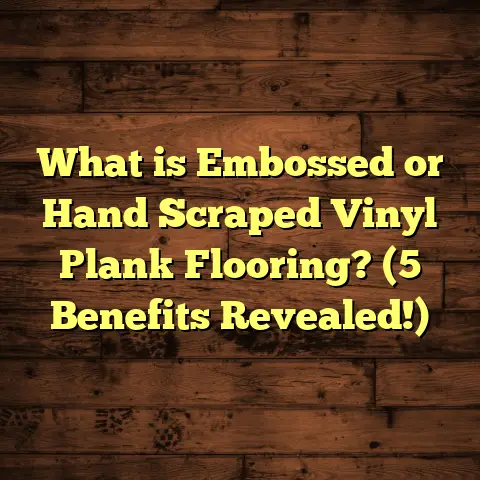What is Wet Room Flooring? (5 Key Benefits for Your Home)
Trends in home design are constantly shifting, and one trend that has really caught my attention lately is the rise of wet rooms. I’ve seen them popping up in modern homes and renovations, and they offer a fresh, practical alternative to traditional bathrooms. If you’re curious what exactly a wet room is and why they might be a great fit for your home, I’m here to share everything I’ve learned and experienced.
What Is Wet Room Flooring?
So, what is wet room flooring exactly? Simply put, a wet room is a fully waterproofed bathroom space where the shower area isn’t enclosed by a traditional shower tray or screen. Instead, the entire floor is designed to handle water directly, gently sloping towards a drain. This means the whole room can get wet without causing any damage.
The flooring in a wet room is more than just a surface you walk on; it’s a specially crafted system that includes waterproof membranes, slip-resistant materials, and proper drainage solutions. The goal is to create a seamless, watertight environment that’s easy to clean and maintain.
I’ve installed wet rooms in several homes over the years, and I’ve come to appreciate how this style of bathroom not only looks sleek but also functions brilliantly. Let me walk you through some of the key benefits I’ve observed.
1. A Sleek, Modern Look That Opens Up Space
One of the first things I noticed about wet rooms is how much they open up a bathroom visually. Without bulky shower trays or curtains, the space feels bigger, cleaner, and more modern.
Why Does This Matter?
Bathrooms are often some of the smallest rooms in our homes, yet they’re spaces we use daily. Making them feel spacious can improve comfort and usability. Removing visual barriers like shower screens or trays means the eye travels uninterrupted across the room. This creates an illusion of more space.
In smaller homes or flats where bathroom space can be tight, wet rooms are a game-changer. Removing barriers means you can utilize every inch without crowding your shower area. For example, in one project I worked on in London, the homeowner wanted to maximize the footprint of their modest bathroom. Switching to a wet room design made the space feel twice as large and flooded with natural light.
The Impact on Property Value
From a resale perspective, modern bathrooms attract buyers. According to data from the UK’s HomeOwners Alliance, updated bathrooms can increase property value by up to 5%. Wet rooms are often seen as a contemporary upgrade that adds appeal.
Design Flexibility
Without shower enclosures dictating layout restrictions, you can be creative with your bathroom design. For instance, you could install a walk-in shower along a wall or even center it in the room if space allows.
Here’s a tip: pairing wet rooms with large mirrors and light-colored tiles further enhances the feeling of openness.
2. Easier Cleaning and Maintenance
Have you ever struggled with scrubbing grout lines in a traditional tiled shower? Or noticed how water tends to pool around shower trays and corners? Wet rooms drastically reduce those hassles.
How They Simplify Cleaning
Because the floor is continuous and slopes gently to a drain, there are no awkward edges or seals where mold or mildew typically grow. This means less time spent cleaning and fewer worries about water damage.
From my experience, clients often tell me how surprised they are at how simple it is to keep their wet rooms spotless. One client shared that their weekly cleaning routine went from an hour-long battle against mildew to just a quick wipe-down.
Materials That Help
Choosing the right flooring material makes all the difference. I’ve found that large-format porcelain tiles with minimal grout lines work wonders for reducing cleaning time. These tiles resist staining and hold up well under moisture.
Vinyl flooring options designed specifically for wet rooms are also popular because they’re resilient and easy to clean.
Data on Maintenance Savings
According to the National Kitchen & Bath Association (NKBA), 67% of wet room owners reported easier maintenance as one of their top benefits after installation. It’s not just about saving time—easier maintenance also means fewer repairs over time due to water damage or mold buildup.
3. Enhanced Accessibility and Safety
Wet rooms are fantastic for accessibility, especially if mobility is an issue for anyone in your household. Because there’s no step-up into a shower tray, it’s much easier to enter and exit the shower area safely.
Why Accessibility Matters
As people age or face mobility challenges, bathroom safety becomes critical. Traditional showers with raised trays can be difficult or dangerous to navigate.
I installed a wet room for an elderly couple last year who were concerned about slipping hazards with their old bathtub setup. The level entry and slip-resistant flooring gave them peace of mind and improved their overall bathroom experience.
Slip-Resistance Features
Slip resistance is key here. Wet room floors are usually constructed from materials like textured tiles or vinyl designed to provide grip even when wet. According to Safety Flooring UK, slip-related falls in bathrooms drop by nearly 30% when using appropriate wet room flooring materials.
Additional Accessibility Options
Wet rooms also allow for easy installation of grab rails, fold-down seats, and other aids without worrying about fitting around trays or enclosures.
4. Waterproofing That Protects Your Home
One of the biggest worries with bathrooms is water damage—leaks can cause all sorts of headaches from structural damage to mold growth behind walls.
Wet rooms use advanced waterproofing systems that cover floors and walls from top to bottom. These membranes create an impenetrable barrier that keeps moisture exactly where it belongs—inside the bathroom.
My Experience With Waterproofing
When I began working on these projects, waterproofing was always a crucial point I emphasized with clients. Over time, manufacturers have developed more reliable materials that make installations safer and longer-lasting.
The process involves laying waterproof membranes beneath floor tiles and on walls up to at least 1.8 meters high around the shower area. This level of coverage prevents any moisture from seeping into subfloors or adjacent rooms.
Real-World Benefits
A case study from a wet room installation company showed that homes with professionally installed wet rooms had 50% fewer water damage claims than those with traditional bathrooms over a five-year period.
This reliability reduces stress for homeowners worried about leaks or costly repairs later on.
5. Flexibility in Design Choices
Another thing I love about wet room flooring is how versatile it can be. Because the entire floor has to be waterproofed, you can choose from a wide range of materials like large-format porcelain tiles, natural stone, or even vinyl flooring with waterproof backing.
Material Options
- Porcelain Tiles: Durable and water resistant; available in many styles.
- Natural Stone: Adds luxury but requires sealing.
- Vinyl: Affordable and easy to install; many options designed for wet areas.
- Epoxy Resin: Seamless and highly waterproof but requires professional installation.
I recall one project where the homeowner wanted an industrial look with concrete-effect tiles combined with warm wooden accents elsewhere in the bathroom. The wet room flooring accommodated this design beautifully while maintaining functionality.
Layout Freedom
Because there’s no need for bulky shower enclosures, you can be creative with layouts—curved walls, open spaces, or even multiple shower heads.
Diving Deeper: Installation Insights
Installing wet room flooring isn’t simply about picking pretty tiles; it involves careful preparation and skilled workmanship.
Waterproof Membrane Installation
The first step is applying a waterproof membrane across all surfaces exposed to moisture. There are liquid-applied membranes that paint on like thick rubber coats and sheet membranes that are adhered mechanically.
I find liquid membranes easier for irregular shapes since they conform without seams but sheet membranes often offer added durability in high-use areas.
Floor Slope Engineering
Proper drainage depends on accurate floor slopes—usually between 1:80 and 1:60 gradients (about 1-2%). Too flat and water pools; too steep and it feels uncomfortable underfoot.
I’ve had jobs where improper sloping caused drainage issues that had to be fixed post-installation—definitely not fun!
Drain Selection & Placement
Choosing the right drain type matters too: linear drains offer sleek looks and can be placed at one side or center; point drains are simpler but require careful floor preparation.
My Personal Story: Learning Through Experience
Early in my career, I was involved in a project where a homeowner wanted a wet room but underestimated the importance of waterproofing prep. The result? Water seeped below floorboards causing damage within months—a costly lesson for both of us.
Since then, I’ve made it my mission to educate clients about the critical steps involved so we avoid problems down the line.
On another note, I remember working with an architect who integrated underfloor heating beneath porcelain tiles in a wet room—talk about luxury! The warmth underfoot combined with the open design made that bathroom one of my favorites ever.
Cost Considerations: What You Should Know
Cost varies depending on materials, labor rates in your area, size of the space, and complexity of waterproofing required.
Typically:
- Basic wet room installation starts around $5,000-$7,000 for small bathrooms.
- Higher-end materials like natural stone or complex layouts push costs above $10,000.
- Retrofitting an existing bathroom involves additional costs due to removal of old fixtures and possible floor modifications.
I use FloorTally often when planning these projects—it helps me estimate costs accurately by factoring local labor rates, material choices, waste percentage, and time requirements into one clear budget projection. It’s saved me from surprises many times and helped clients feel confident moving forward.
Comparing Wet Room Flooring With Other Bathroom Flooring Options
It’s helpful to see how wet rooms stack up against traditional options:
| Feature | Wet Room Flooring | Shower Tray + Tile Floor | Bathtub + Tile Floor |
|---|---|---|---|
| Waterproofing | Full room waterproofed | Waterproof under tray only | Partial waterproofing |
| Space Efficiency | Maximizes usable space | Shower enclosure takes space | Bathtub occupies space |
| Cleaning Ease | High (seamless floor) | Moderate (grout & tray edges) | Moderate (grout & tub edges) |
| Accessibility | Level access possible | Step-in required | Step-over tub edge |
| Installation Cost | Higher upfront | Moderate | Varies |
| Safety | Slip-resistant options | Depends on tray material | Depends on tub surface |
Maintenance Tips for Your Wet Room Flooring
To keep your wet room looking great:
- Clean regularly with mild detergents.
- Avoid harsh chemicals that damage grout or membranes.
- Inspect grout lines annually; reseal if necessary.
- Ensure drains remain clear to prevent water pooling.
- Use mats outside the shower area if desired for extra grip.
Clients often ask me about mold prevention—I recommend good ventilation combined with regular cleaning as key factors.
Future Trends Around Wet Room Flooring
Looking ahead:
- Advances in waterproof membrane technology will continue improving durability.
- New slip-resistant tile textures enhance safety without sacrificing style.
- Smart home integration may include moisture sensors embedded beneath floors.
- Sustainable materials like recycled porcelain or eco-friendly vinyls will grow in popularity.
I’m excited by how innovation continues making wet rooms more accessible and appealing for all kinds of homes.
Wrapping Up My Thoughts
If you’re thinking about upgrading your bathroom or designing a new one, wet rooms are worth serious consideration. They offer clear benefits like spaciousness, easier cleaning, safety improvements, solid waterproofing, and flexible design choices.
From my hands-on work installing these spaces and talking with homeowners afterward, I can say wet rooms add real value both practically and aesthetically. Plus, as trends continue shifting toward minimalism and smart use of space, I expect we’ll see more people embracing this style.
Have you seen or used a wet room before? What’s your take? I’d love to hear your thoughts!





